Blog Archives
What Happened Today at the Monastery?

We start up a six-day phase after a powerful, creative fulfilling three-day retreat. Here is Bodhinatha given his Sun One talk on spiritualizing daily life.
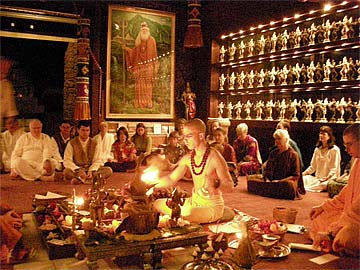
Yogi Japendranatha performs the homa…
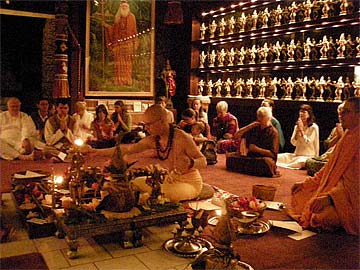
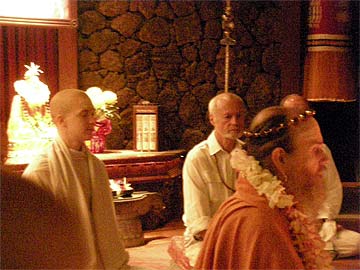
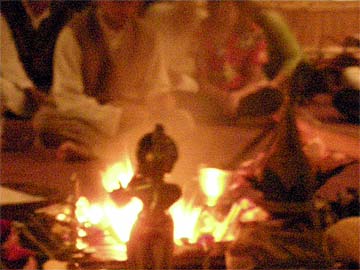
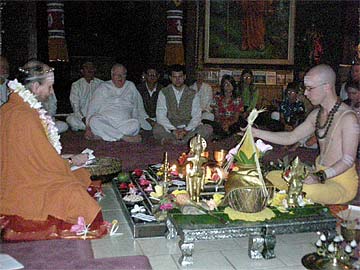
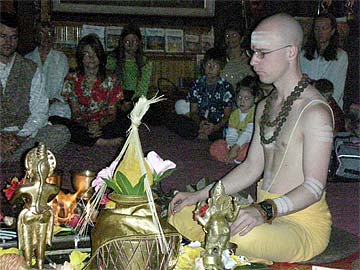

Our very devoted family from Denmark was invited to the homa today. The children were “awestruck” by the ceremony.
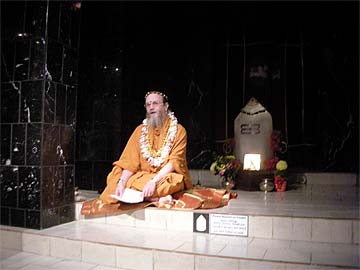
We will finally meet our goal this phase of posting Bodhinatha’s latest talk with transcription in the same week he has given it. Watch the side bar. We are posting a new talk link daily.

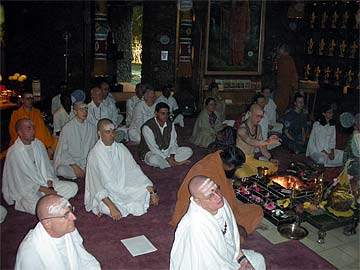
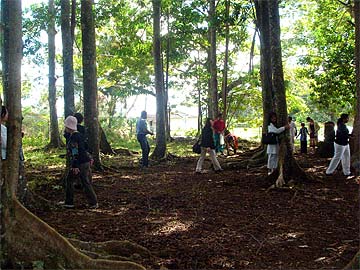
Host Brahmacharini Shama Kumaran share some of the guests adventures she has had today.
Mrs. Hatoyama and a group of Japanese ladies arrived from Japan to visit the Aadheenam grounds and the Iraivan Temple. A Hindu family also joined the group in the sacred Rudraksha forest and everyone hugged the trees.
Why do they hug the Rudraksha trees you ask? These trees are sacred and, when hugged for a few minutes, they will take all the negative energy out of you up into the tree and you are left feeling completely peaceful. The seeds therefore are called “the compassionate tears of God Siva for all humanity.”
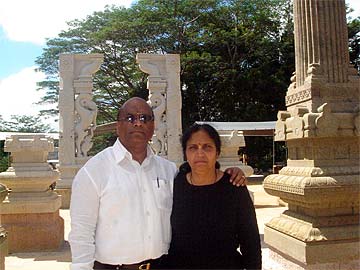
It is wonderful to see so many Hindu families visiting the temple. Some hear about the temple while vacationing on Kauai, while others make the temple pilgrimage the reason for visiting the Kauai.
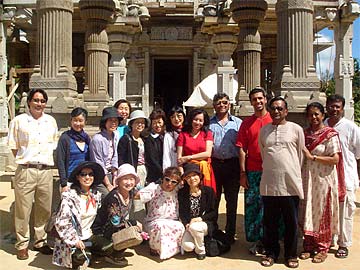
At the Iraivan temple complex in front of the Tara pillars are our wonderful visitors from Japan and the Hindu family who pilgrimaged to Kauai is to the right of them.
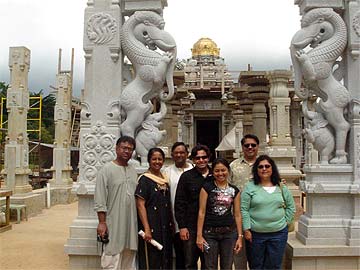
Another beautiful morning with more wonderful Hindu families visiting the iraivan Temple.
Here in front of the Yallis are Milind and Nirupama Korde from San Jose, CA, Veer and Esha Bhavanandan from Tempe, AZ, Kamal and Rushita Rupareliya from Burbank, CA and Raju Sivanathan from Phoenix, AZ.
Kauai Newspaper Feature Story on Silpis
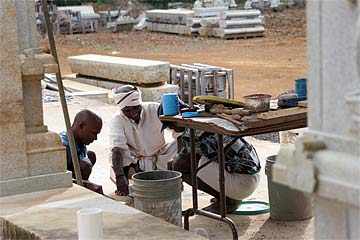
Kauai’s one and only newspaper “The Garden Island” did a feature story on the silpis of Iraivan. We share with you the text of the article below. (We didn’t have access to the photos that appeared with the article, so have substituted some of our own that are close.)
Housed in Stone,
Carvers Chip Away at Time
by Keya Keita – The Garden Island
Posted: Friday, Mar 02, 2007 – 09:29:11 am HST
WAILUA — High above an emerald green valley, dripping with tropical vines and ancient trees, a gentle tapping of iron and stone fills sunlit hours. Six master stone carvers from Karakudi in Southern India are patiently carving the intricate details on pillars of granite, one chip at a time. The gentle tapping of the iron and stone is reflected in the hand-made monument that many would believe was carved from deafening machines and electric tools. The founding Guru of this temple, Satguru Sivaya Subramuniyaswami (Gurudeva, 1927-2001), is responsible for having chosen the site of the monastery as well as envisioning the cultural exchange that is now being carried out in order to build the permanent structure.
Added together, the six artists working on this place of worship have 98 years experience — several began as young as 13 years old. This commission is called, by those involved, a unique and honorable work, as it is the first time that a Hindu temple is being fabricated with the identical traditional methods used in India over 1,000 years ago. The artisans work six days a week, for two years, before returning to their home. When asked if this time away is a terrible hardship, they say, “It is a typical aspect of the stone carver’s job to be away from home working on a site for several months per year. In addition, we are so pleased to be working on this project in Kaua’i and we see it as a once-in-a-lifetime experience.”
The translator for the Tamil-speaking artisans, Yoginathaswami, a monk at the temple, added, “for this birth and perhaps many to come, they feel this is a unique and wonderful opportunity.”
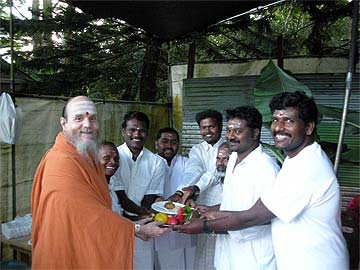
The tradition of carving in India is regarded differently depending on what it is one is carving. Temple carvers hold a higher respect among Indian society than craftsman who make tools or everyday items. While three of Kaua’i’s visiting artists came to the profession because their fathers or grandfathers also did the work, the other three came to it on their own, out of interest and desire. The training of the craft costs time and determination — it takes a minimum of six years to begin a professional career as a carver. Working one’s way through apprenticeship in tools and labor eventually allows the aspiring carver time to practice on scraps lying about at the work site. Practicing chipping away at solid stone is done over lunch breaks and free time. Once the apprentice feels they are able to make rough forms, they approach the construction coordinator out of their own volition to apply for a position. Several years are spent learning how to smooth surfaces and carve general pictorial forms, yet the exquisite details of Hindu temples are left only to the very experienced master carvers, called Silpis.
The temple structure is not erected simply by standing pillars and stone to form several chambers and entry ways. There is a sacred science, highly protected from public knowledge, that informs the architectural engineering of such a special space.
The temple architect called a Sthapati, is a highly educated engineer and designer who is fluently versed in a sacred mathematical formula that is used to plan all temple structures. One of the Silpis said, “For every 100 Silpis, there are only two Sthapati in India.” While many Silpis may aim toward one day becoming a Sthapati, the “sacred knowledge of spiritual mathematics is dearly coveted,” said Yoginathaswami. The Iraivan Temple in Wailua is constructed based on an 11-foot, 71/4 inch pattern that was derived from calculations of astrological positioning, the temple’s honored deity “Siva” and the founding Gurudeva’s name. This spiritual architectural calculation is meant to connect the divine and the material.
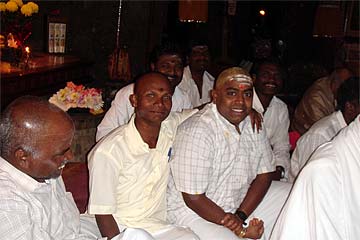
“From their perspective, even after years of professional expertise, the Silpis have the technical knowledge, but they lack the theoretical wisdom that informs the actual design of the space.” Yoginathaswami said.
The extensive meaning in each and every aspect of the temple, pictorially defining a complex theology, hints at the depth of how this structure is already a place of divinity and worship. The visiting artists feel that their experience working here has been “life-transforming and illuminating.” They explained the drastic difference between working on a typical temple project in India and Kaua’i’s temple, “We credit Gurudeva, the founder of the temple, for making the working experience be a spiritual experience. At other jobs, you arrive in the morning and work all day. If you make a mistake, you are fired on the spot. Gurudeva felt that this work should be peaceful and joyful. We begin each day with communal worship and prayer. This unites us in our cause and work and the mood is carried throughout the day. No matter what our individual beliefs, we are united when it comes to this project. Gurudeva insisted that we carve everything by hand in the tradition of Hindu temples in India — this has greatly improved our skills as Silpis.”
The building of the temple begins on a large construction site in India, where the Sthapati oversees many carvers who flesh out the pillars in rough form. As the 3,000 pieces of stone are completed, they make their journey by sea to Nawiliwili and up to the Wailua property to slowly be placed and then finished by the resident artisans. The details that the carvers are fashioning are so intricate and expansive that it is difficult to fathom this is all being done with rough chisels held by 12 hands.
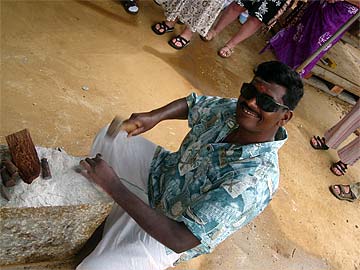
On monthly outings over the past 20 months, the artisans have visited every tourist site on the island — from Waimea to the Napali Coast — but when asked what their favorite spot to visit is they sheepishly said, “Wal-Mart.”
The spectacle of “having everything from 100 stores in one single store is fascinating to them.” Yoginathaswami said.
“We have also taken them for coffee at the Grand Hyatt and Princeville Hotel — this is something they could never arrange to do in their own country.” Tourist resorts are carefully guarded in India and non-guests are not allowed on the premises.
The two years the artists have spent working on Kaua’i seem short in the lifetime of the structure they are building. The Silpis expressed their gratitude for the opportunity and experience, but the temple will last far beyond the years of any current resident or worker.
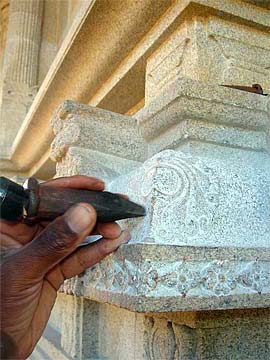
Chipping away at time is the task of these master craftsmen.
Yoginathaswami recounted a story from a recent visitor: “After touring the construction site the visitor remarked how we often look at great world monuments, temples and ancient structures and wonder what it was like when they were building them. This is one we can all be witness to.”
Long after the temple is finished, the echoes of the “chip, chip, chip” of these artisans will eternally be housed in the stone, and visitors from all over the world will marvel at who could have done this, and how.
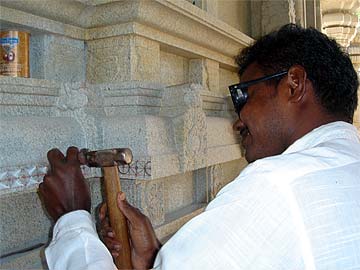
From Our Gurus' Teachings
Archives are now available through 2001. Light colored days have no posts. 1998-2001 coming later.
